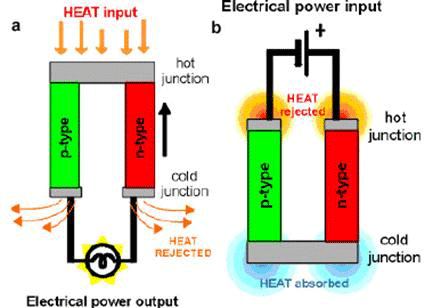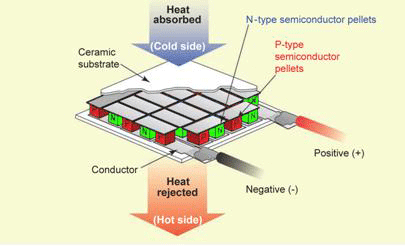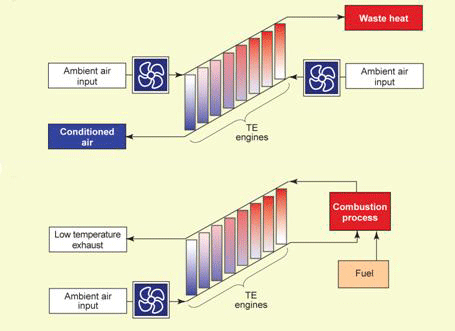Thermoelectric devices that scavenge waste heat to generate electricity improve efficiency of fuel consumption and replace bad greenhouse gas refrigerant Dr. Mae-Wan Ho
Automaker BMW is pushing ahead with its second-generation efficient Dynamics green car technology by harvesting waste heat from the exhaust and turning it into electricity [1]. BMW’s head of development Klaus Draeger says it will boost fuel economy by some 5 percent on the combined cycle, and is expected to hit the showrooms by 2014.
The secret is a thermoelectric generator (TEG) similar to those that power satellites. By using waste heat from the engine’s exhaust, around 200W power could be generated
In 2008, another automaker GM had already announced they would produce a thermoelectric car prototype in 2009 [2]. GM researcher Jihui Yang said that the TEG harvesting the exhaust heat will produce 800 W of electricity when its Suburban is cruising at about 50 to 60 miles per hour.
John Fairbanks of the US Department of the Environment said TEGs should be on the verge of production in about three years. The US Department of Energy’s ‘FreedomCar’ target is for both cars and trucks to improve overall fuel economy by 10 percent [3].
Harvesting heat is particularly fascinating because heat is normally the end of the line as far as energy transformation is concerned. Turning it back into useful energy effectively recycles the waste energy thereby increasing overall energy efficiency. (This brings it closer to the circular thermodynamics of living organisms and sustainable systems [4] (see The Rainbow and the Worm, The Physics of Organisms, ISIS publication.)
Another application high up on the list is air cooling and refrigeration, in replacing the need for the most common refrigerant R-134a used in home and automobile air conditions [3] that has a greenhouse warming potential 1430 times that of CO2. It will be banned in new European cars by 2011; and the US DoE recently announced a US$13 million cost-shared programme to develop TE technology for cooling.
What makes both heat harvesting and cooling applications possible is the thermoelectric (TE) effect, the conversion of temperature differences into electricity and vice versa. A thermoelectric generator creates an electrical voltage when there is a temperature difference on each side. Conversely, when a voltage is applied, it creates a temperature difference. Hence the effect can be used to generate electricity, or as a heat pump to heat or cool objects and spaces (see Box 1 for further details); and depends on special TE solid state semiconducting materials.
Box 1
The thermoelectric effect and its applications [5-9]
The thermoelectric (TE) effect converts temperature difference into electricity and vice versa. Historically it was the combination of three different observations.
Prussian physicist Thomas Johann Seebeck (1770-1831), discovered the Seebeck effect in 1821. A compass needle deflected when placed near a closed loop formed from two dissimilar metal conductors if the two junctions were kept at different temperatures. The magnitude of the deflection (indicative of a magnetic field) was proportional to the temperature difference and the type of conducting material, and not on the temperature distribution along the conductors. The Seebeck coefficient is defined as the open circuit voltage produced between two points on a conductor where a uniform temperature difference of 1 K exists between the two points.
The Peltier effect described in 1834 by French physicist Jean Charles Athanase Peltier (1785-1845) refers to thermal effects at the junctions of dissimilar conductors when an electric current is passed between the materials. Heat is absorbed or generated at the junctions depending on the direction of current flow.
The Thomson effect was predicted and subsequently experimentally observed by Willian Thomson, later Lord Kelvin (1824 – 1907) in 1851. It describes the heat generated or absorbed in a current-carrying conductor subjected to a temperature gradient. The three TE effects are related by the Kelvin relationship
Later in 1909 and 1911, German physicist Edmund Altenkirch showed that good thermoelectric materials should possess large Seebeck coefficients, high electrical conductivity (to minimise Joule heating due to electrical resistance) and low thermal conductivity (to retain heat at the junctions and maintain a large temperature gradient). These three properties were later embodied in the ‘figure of merit’, zT.
 (1)
(1)
Where S is the Seebeck coefficient of the material (measured in mocrovolts/K), s is its electrical conductivity, k its thermal conductivity, and T temperature in deg. K.
The development of semiconductors in the 1920s with Seebeck coefficients in excess of 100 microvolts/K increased interest in thermoelectricity. Russian physicist Abram Fedorovich Ioffe (1880-1960) showed in 1929 that a thermoelectric generator using semiconductors could achieve a conversion efficiency of 4 percent, with further possible improvement in its performance. By the 1950s, Ioffe and colleagues had developed the theory of thermoelectric conversion.
TE devices have been in production since the late 1950s, beginning with military applications, such as sensors of infrared imaging systems for heat-seeking missiles and night-vision systems. The development of silicon germanium high-temperature power-generation materials led to the production of heat engines for space applications with no moving parts that could operate in the absence of sunlight. All power sources for US and former USSR deep-space probes have used TE heat engines to convert heat generated by nuclear fissile material to electricity.
TE devices are now in mass production for cooling, heating, and temperature control applications. Miniature TE modules keep laser diodes at constant temperature to stabilize operating wavelengths. Polymerase Chain Reaction systems use TE devices to thermally cycle microlitre quantities of enzymatic reactions through exact series of temperature cycles. Climate-control systems have been developed for rapid seat cooling in the summer and equally fast heating in the winter. Portable beverage and picnic coolers were early commercial applications. Personal temperature-control systems that provide cooling as well as heating for the office have come onto the market, as have TE-based cooling systems for computer boards. One main application is power for remote data communication systems for oil and gas pipelines, polar weather station power generators, and cathodic protection for oil drilling platforms. TE generators are chosen for these applications because of their proven reliability (often maintenance-free for 20 years), durability under extreme conditions, and very little if any degradation in performance over their operating life time.
The simplest TE device consists of a TE couple, two dissimilar semiconductors, a p-type and n-type [5]. It is connected electrically in series and thermally in parallel. To get a thermoelectric generator (Fig. 1, left), heat is pumped into one side of the couple and rejected from the opposite side. An electric current is produced in proportion to the temperature gradient between the hot and cold junctions. Electric current is propagated by electrons in the n-type semiconductor and by holes travelling in the opposite direction in the p-type semiconductor.
If a voltage is applied to the TE couple across in the right direction
(Fig. 1, right), electron/hole pairs are created near the p-n junction. Electrons will flow away from the junction in the n-type material, as will holes in the p-type material, absorbing heat in the process and cooling the junction. Electron and hole recombine at the opposite end, generating heat. Thus it will effectively pump heat from the cold to the hot junction. The cold junction will rapidly drop below ambient temperature provided heat is removed from the hot side. The temperature gradient will vary according to the magnitude of current applied.

Figure 1 Thermoelectric device
Left, generator; right, cooler
A typical TE module consists of many TE couples connected electrically in series and thermally in parallel (Fig. 2).

Figure 2. A thermoelectric module
TE devices are easy to construct and robust in operation. The main drawback is the low efficiency. The dimensionless ‘figure of merit’ zT expresses the efficiency of the semiconducting materials that make up the TE couple (see Box 1). In today’s best commercial TE cooling/heating modules, zT is about 1.0 [9], which gives an efficiency one-quarter that of a conventional air-conditioning systems using gas/liquid two-phase fluids, where the heat rejection and cooling parts of the system can be widely separated, and large temperature differences do not lead to the high heat backflow that destroys the efficiency of TE systems. Ideal TE system efficiency increases nonlinearly with zT, so to double efficiency, zT has to increase to about 2.2, and to achieve fourfold increase to equal efficiency of today’s two-phase refrigeration, zT would have to increase to more than 9.2.
In 1993, the US government’s Office of Naval Research and Defense Advanced Research Project asked researchers to propose improvements of zT for cooling and heating applications. This has resulted in major efforts dedicated to making new semiconducting materials and in the design of the modules. Only three efforts have produced zT values in excess of 2 [9], but they are still in the laboratory.
In 2008, researchers have boosted the zT of bulk semiconducting material to 1.5, (see Box 2), which is beginning to make thermoelectric devices commercially viable, particularly at the small scale, and in combination with other design improvements (see below).
The efficiency of thermoelectric energy converters is limited by the figure of merit zT (see Box 1). One promising approach to increasing zT involves creating materials with nanometer-scaled morphology to dramatically lower the thermal conductivity k by scattering phonons. Quantum-dot superlattices have reported values of zT > 2, and silicon nanowires have such a reduced k that zT approached that of commercial materials. But these are still in the laboratory and not in the bulk material that can be used commercially.
In 2008, two research teams reported significant improvements in zT of bulk semi-conducting material that are much closer to the market.
The research team led by US scientists Gang Chen at MIT Cambridge, and Zhifeng Ren at Boston College Chestnut Hill, in Massachusetts, significantly boosted zT simply by ball-milling crystalline ingots of p-type bismuth antimony telluride BixSb2-xTe3, and hot pressing the nanopowders into solid discs [10]. When tested, these solids gave a peak zT of 1.4 at 100 C. The enhanced zT is the result of a significant reduction in thermal conductivity due to strong phonon scattering by interfaces in the nanostructures. Apart from the peak zT of 1.4 at 100 C, the material has a zT of about 1.2 at room temperature and 0.8 at 250 C. In comparison, conventional Bi2Te3-based materials commercially used have a peak zT of about 1 at room temperature and about 0.25 at 250 C. The high zT of the present material in the 25 C to 250 C range makes the material attractive for cooling and low-grade waste-heat recovery applications, such as (suggested elsewhere) harvesting body heat to run electrical devices [11]!
The research team led by Joseph Heremans at Ohio State University, Columbus, in the United States took another approach, working on the p-type material lead telluride PbTe. Its minimum thermal conductivity is already quite low, and they decided that progress must come from other sources, in the numerator of eq. (1), such as the Seebeck coefficient S.
The research team succeeded in doing just that, by doping PbTe with thallium [12]. At a level of doping of 2 percent thallium, zT was increased to 1.5 at 773 K, and still increasing. It appears that thallium distorts the electron density of the material, increasing it over a narrow range, probably due to the valence band of the host semiconductor resonating with one energy level of a localized thallium atom in the semiconductor matrix. The temperature range where the TlPbTe material exhibits high zT values is particularly appealing for power generation from waste heat sources such as the automobile exhaust.
Apart from increasing material zT, it is possible to making significant design improvements for thermodynamic efficiency and to reduce parasitic losses. Some examples are given by Lon Bell [9] at BSST, a company based in Irwindale, California. Using a counter flow pattern, heat transported from one fluid to the other is modified by the TE engines. In the cooling/heating mode (Fig.3 top), the TE elements boost the heat quality so that one of the opposing fluid streams is heated and the other cooled, the efficiency can be about double that of a single module operating with all the elements at the same temperature. In the power-generation mode (Fig. 3 bottom), the efficiency gains about 30 percent compared with TE heat engines in which the incoming working fluid is combusted without being preheated by the waste side of the array. This design is yet another example of the circular thermodynamics of organisms I referred to earlier [4].
The cycles can be combined with higher zT materials to compound the performance gains.

.Figure 3. Thermodynamic cycles to optimize the performance of TE engines
Top, cooling mode; bottom, power generation mode
A further improvement is to reduce the amount of material used in construction. In real devices, system performance degrades as the device is made smaller, because the relative impact of parasitic electrical and thermal loss mechanisms increases as size decreases. Also, manufacturing tolerances and electrical isolation requirements place practical constraints on device size. An alternative, stacked configuration for TE elements, for example, reduces parasitic losses from the electrical connections, and better still, if used in combination with a reduction in the electrical resistance at the TE material/shunt interfaces. Under many practical operating conditions, the weight of TE material used can be reduced by a factor of 6 to a factor of 25. The stacked configuration, for example, reduces material costs considerably for high-capacity system. For TE cooling and heating systems, the traditional configuration is cost-competitive up to about 400 thermal watts output, but increases to about 4 000 W with the stacked design.
Average zT in the range from 1.5 to 2 would enable substantial waste-heat harvesting as well as primary power-generation applications. Various government-sponsored programmes are underway in the US and Japan to increase vehicle mileage by converting a fraction of the heat in the exhaust of trucks and cars to electric power (see above). The power would be available for power steering, brakes, water pumps, turbo chargers and replace other vehicle subsystems such as the alternator, thereby reducing the weight carried. The energy target of 10 percent fuel reduction is within reach [9].
Gains of 5 to 10 percent would be possible in small scale diesel-powered cogenerators that are becoming widely used in developed countries and for 5000 to 20 000W primary generators in developing countries. In another proposed co-generator concept, the solar spectrum is split into shorter wavelengths that yield high photovoltaic conversion efficiency and longer wavelengths that heat a TE generator.
Another potential application, I suggest, is to use heat from low energy nuclear reaction (also referred to as condensed matter nuclear reactions) [13, 14] (see From Cold Fusion to Condensed Matter Nuclear Science, SiS 36; Low Energy Nuclear Reactions for Green Energy , SiS 41) to generate electricity with TEGs
Industrial waste-heat recovery in aluminium smelting, glass manufacture, and cement production is practical at a zT of 2. At the same zT, it may also be possible to replace small internal combustion engines such as those used in lawn mowers, blowers, and small outboard motorboats with external combustion TE engines, These engines would be very quiet and nearly vibration free. They would burn a wide spectrum of fuels, such as propane, butane, natural gas (including biogas methane [15] The Biogas Economy Arrives, SiS 40), and free us from fossil fuels.
If the average zT reaches 2, room, home, and commercial TE heating ventilating and air-cooling systems become practical, replacing R-134a.
Because of their ruggedness, portability, and ready ability to be electrically powered, TE systems should provide more-efficient and better performing temperature control in vehicles of many types including cars, trucks, trains and aircraft.
Article first published 21/04/09
Comments are now closed for this article
There are 5 comments on this article.
Todd Millions Comment left 5th May 2009 15:03:16
Clearly done with updates I'd not come across before-Good job.
Now where to start-improved stove /light gas appliance potential with trickle charge of batteries,on nessary fuel use.
Another approach with this ,in engine use would be further work on the peizo electric based generators tried in the 1960's,to convert the vibration of car motors to enough electrical power to replace the alternator-not quite enough though durability was reported as good.
Refrigeration-more efficency would be available if the waste heat from these were used to evaporate say ammonia or other absorbsion coolants.if the fridge ran on intermitent power,the stored seperated absorbing liquids,could be combined too chill later.Thus enhancing cooling coeficent and extending operations.
Rory Short Comment left 22nd April 2009 23:11:04
What is so interesting to me from reading an aeticle like this is that the replacement of fossil fuels by sustainable energy sources will be much more rapidly achieved if governments and industry make such R&D their top priority. It is really a question is it not of where we direct our resources.
Tom Comment left 2nd June 2009 22:10:44
There is a company Amerigon stock ARGN readers might be interested in. They make heated/cooled car seats and drink cups now but plan to release an engine heat recovery system soon that will improve gas milage.
Paul Riley Comment left 2nd June 2009 22:10:39
I'm currently researching a solar panel project that uses a thermoelectric generator sandwiched between a high efficiency solar absorber and a heat exchanger fed from a domestic cold water supply on the other. The idea being that the arrangement provides both electric power by ensuring a high deltaT across the generator and domestic hot water as well. Has anyone come across anything similar or could suggest papers that I might read as the claims made for the system seem incredibly optimistic?
manju Comment left 2nd September 2010 23:11:51
hai.. i want thermoelectric generator (TEG) for my project is it available in India. and where it is available, and what it may cost for power goration of 10w by using 80 degree celsius heat,
is it possible to manufacture thermoelectric generator (TEG) by my self and how?